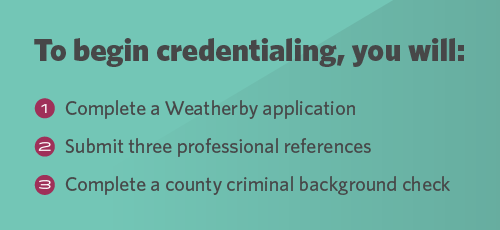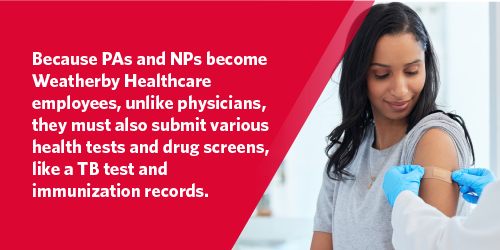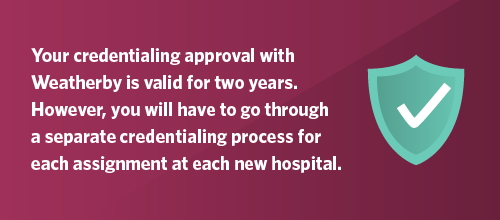Physicians, physician assistants, and nurse practitioners all undergo a thorough credentialing process when working locum tenens assignments with Weatherby. But what does that process entail? Here are eight things you should know about how credentialing works and how you can make the process easier.
1. Credentialing ensures patients are treated by quality providers
According to the National Institutes of Health, credentialing is “the process of assessing the academic qualifications and clinical practice history of a healthcare provider.”
The point of credentialing is to confirm your professional identity and qualifications. Weatherby requires this process to ensure they’re sending quality providers to work locums assignments.
2. Getting credentialed starts with an application

You’ll complete Weatherby’s application, which asks for education and employment history, any licenses or certificates you hold, and any hospitals you’ve been affiliated with or done procedures at.
You must also name at least three references, including two from clinicians within your specialty. Make sure you submit each person’s current and correct contact information. Your references should be able to speak to your competency over the past two years, especially in procedures you’ll be expected to perform on your assignment. If you’ve completed your post-graduate training within the last nine months, you should also list your program director as a reference.
This step also includes a county criminal background check.
3. Weatherby will verify the information submitted
Once you have submitted your application, your documents are reviewed by Weatherby’s team. Your education, board certification, and all licenses (including DEA and controlled substance licenses) are verified directly.
The team also reaches out to previous places of employment and hospitals where providers hold privileges to ensure you’re in good standing. Hospital privileges held within the last six months for six weeks or longer are also verified.
During this step, the team will also reach out to your references and ask them to rate your ability to perform various procedures, among other questions.
Do you have the right license? How state licensing for locum tenens works
4. You may need to provide additional documents
Remember that depending on your specialty, you may need to provide supplementary documentation. For example, if you’re seeking a pediatric locum tenens position, there’s a pediatric life support certificate you will need to provide.
Any supporting documentation can be sent via email, fax, or mail to the locum tenens credentialing team. However, in most cases, education certificates or medical license copies aren’t required, as the credentialing team will reach out to the source directly to verify them.
5. The process is slightly different for PAs and NPs
Because locum tenens advanced practice professionals become Weatherby Healthcare employees, unlike physicians, PAs, and NPs must turn in various health tests and drug screens, like a TB test and immunization records.
They must also fill out identification verification forms on the first day of an assignment.

We’ve got you covered: Benefits offered to NPs and PAs who work with Weatherby
6. Non-US citizens must undergo a few extra steps
Providers who are not US citizens are required to submit proof of permanent resident status and/or employment authorization documents. Certain work authorization visas aren’t acceptable for work with Weatherby, such as the H1B visa.
7. Your credentialing approval is valid for two years
Once you have passed credentialing with Weatherby, you won’t need to go through the process again for another two years. However, you will have to go through a separate credentialing process for each assignment at each new hospital. That’s because each facility has its own requisites and insists on its own primary source verifications.

For Weatherby providers, the credentialing team pre-populates the hospital application with the information to save you time. So even if you take on a new assignment, the credentialing process is more streamlined — and less of a heavy lift.
After the team fills out as much of the information it can, it’s sent to you to finish. From there, the credentialing team works directly with the facility to fill in any blanks or answer questions. The team’s goal is to save you time so you can treat patients rather than fill out paperwork.
8. On average, it can take up to a month to be credentialed, but you can help speed up the process
The average credentialing turnaround is 28-30 days before approval is given.
As an applicant, timely communication with Weatherby’s staff can help prevent delays. Let them know whether you prefer email, phone calls, or even text messages so they can reach you quickly.
You can also help by streamlining communications with your references by alerting them that Weatherby will be reaching out to them.
Are you interested in learning more about locum tenens as a career alternative? Give us a call at 954-343-3050 or view today’s locum tenens job opportunities.


